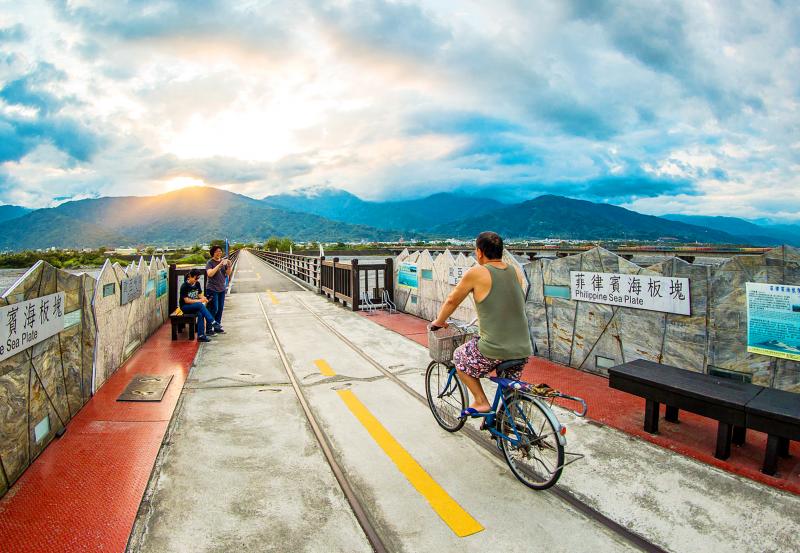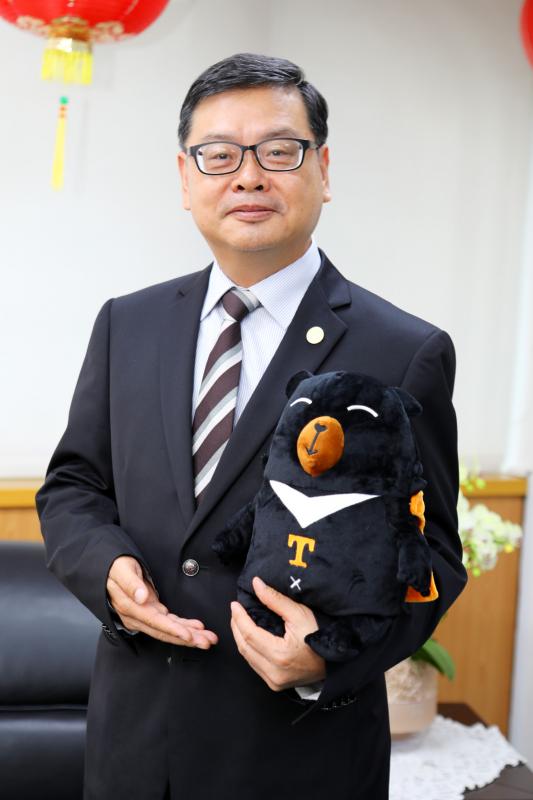“Well, if it cannot happen this year because of the pandemic,” Tourism Bureau Director General Chang Shi-chung (張錫聰) says at the end of his interview with Cycling Shorts last week, “at least we’ll be ready to promote it next year.”
Chang is discussing the Year of Cycling Tourism (自行車旅遊年) that has long been planned for this year. He has spent the previous 30 minutes introducing the various infrastructure projects undertaken over recent years and those proposed for the next few.
Essentially, the Bureau, under the Ministry of Transportation and Communications (MOTC), has been pulling together resources from a wide range of national and local government agencies, as well as private companies and NGOs.

Photo courtesy of the Taiwan Tourism Bureau
These include the Construction Department of the Ministry of the Interior, Sports Department of the Ministry of Education; bodies overseeing the country’s national parks, Railway Administration, High Speed Rail and bus companies; representatives of the hotel and catering industries as well, of course, as the main bicycle manufacturers and tour companies; and cyclists’ groups such as the Cycling Life Style Foundation (自行車新文化基金會).
This means that after a decade or more of piecemeal development of short cycle paths in numerous towns, cities and counties, these have now been woven together into a network of routes that totals more than 4,000 kilometers and is still growing.
Where designated paths are not possible, a blue bicycle lane has been painted along main roads to enhance safety. Also, where feasible, alternative routes through quiet farming villages have been mapped out that do not add greatly to the distance.

Photo courtesy of the Taiwan Tourism Bureau
TAKING A BREAK
Provision of rest areas has also been increased and their services enhanced, Chang says, so that now every eight to 12 kilometers on a round-island ride cyclists can find places to wash and sit down. There are also toilets and drinking water fountains, simple medical kits and even some tools for bicycle maintenance. In addition to such services at almost every police station islandwide, railway stations and local government offices have also now been added.
Shortly before officially launching the program, Minister Lin Chia-lung (林佳龍) led the heads of all MOTC units, including the Tourism Bureau, on a round-island relay between Nov. 28 and Dec. 4 last year.

Photo courtesy of the Taiwan Tourism Bureau
So, although not a regular cyclist himself, Chang has tasted the experience of cycle touring. What were his impressions?
“Vulnerability,” he says.
Wherever there was a section of the route that was not on a dedicated bicycle path, he felt intimidated by the cars and trucks.

Photo courtesy of the Taiwan Tourism Bureau
This is why the MOTC spent so much money linking various local government implemented bicycle networks, he says, referring to the NT$3.2 billion (US$114 million) earmarked in 2019 to be spent over the following four years.
He then outlines the “seven multiple routes and nine tour experience routes” specifically created for promotion in the cycle touring year. The former includes the north and northeast coasts, Yilan Plain, several routes further down the east coast and one on the Penghu Islands; the latter involve rides with more climbing, such as into the foothills of Yunlin and Chiayi counties, as well as a ride up to Sun Moon Lake.
WHO’S LEADING WHO
It is hard to stop one’s mind from wandering back to last week’s column, “If you build it, they will ride,” about the 200-plus kilometers of riverside cycle paths built over the last two decades in Taipei and surrounding areas that have been a significant factor in transforming Taiwan into a nation of cycle lovers.
Is the MOTC, like the Taipei City Government of the 1990s, showing insight in developing similar islandwide facilities to encourage the hundreds of thousands of riverside cyclists to expand their horizons and head off around the island?
Or, on the contrary, is it simply responding to citizens’ needs after this horizon-expansion had already happened of its own accord? Or perhaps it’s a bit of both.
After all, attempting a huandao (環島, round-island) ride entered the popular imagination following depiction of just such a feat by the long-haired, guitar-playing protagonist of Chen Hwai-en’s (陳懷恩) 2006 movie Island Etude (練習曲).
It’s now almost de rigueur for graduating students to spend a week-plus riding the thousand kilometers or so around Taiwan. And, having completed it, often on a borrowed or rented machine, many discover the pleasures of cycling and take up the pastime on a more regular basis.
The route has also come to the attention of cycling communities in Asia and beyond, and it is not uncommon to meet Japanese, Malaysians, Filipinos and other cyclists visiting Taiwan specifically to undertake this challenge.
Asked if visitors from these countries would be a primary focus of the Tourism Bureau’s marketing, Chang says that tourists interested in visiting Taiwan “will be treated equally and enthusiastically, irrespective of nationality, skin color or gender.”
Curiously, the bureau’s most recent statistics for 2019 estimate that, of the 300,000 foreign visitors who cycled during their stay in Taiwan, the largest group at 21 percent came from China, followed by Europe (11 percent), Japan (10 percent), Hong Kong and Macau (10 percent) and South Korea and North America (7 percent each).
But, Chang goes on to say, this includes everything from renting a YouBike for a 10-minute ride in the city, to bringing one’s own bike to tour in the mountains or participate in an elite event.
He points to figures from Giant Bicycles which, as well as being the world’s top manufacturer of bikes, is also one of the nation’s main renters of higher-end touring bikes. These suggest that the main groups of visiting cyclists do indeed come from Hong Kong, Singapore and Malaysia, with most coming for three to nine days, and riding either along the east coast or East Rift Valley between Hualien and Taitung, or completing a huandao.
Perhaps MOTC officials pay attention to the numerous blogs, vlogs, Facebook and other social media posts by these riders. Certainly many of the infrastructure investments Chang mentions relate to improving safety and getting cyclists out of cities and into the countryside as quickly as possible, two concerns often mentioned.
So, whether foreign cyclists do manage to get to Taiwan during the 12 months of the program is, as Chang says, not really a problem. He is clearly confident that Taiwan’s magnificent scenery, enhanced by tourism professionals and entrepreneurs, will continue to attract large numbers for years to come.
Mark Caltonhill bikes, and writes, and writes about bikes.

Most heroes are remembered for the battles they fought. Taiwan’s Black Bat Squadron is remembered for flying into Chinese airspace 838 times between 1953 and 1967, and for the 148 men whose sacrifice bought the intelligence that kept Taiwan secure. Two-thirds of the squadron died carrying out missions most people wouldn’t learn about for another 40 years. The squadron lost 15 aircraft and 148 crew members over those 14 years, making it the deadliest unit in Taiwan’s military history by casualty rate. They flew at night, often at low altitudes, straight into some of the most heavily defended airspace in Asia.

Beijing’s ironic, abusive tantrums aimed at Japan since Japanese Prime Minister Sanae Takaichi publicly stated that a Taiwan contingency would be an existential crisis for Japan, have revealed for all the world to see that the People’s Republic of China (PRC) lusts after Okinawa. We all owe Takaichi a debt of thanks for getting the PRC to make that public. The PRC and its netizens, taking their cue from the Chinese Communist Party (CCP), are presenting Okinawa by mirroring the claims about Taiwan. Official PRC propaganda organs began to wax lyrical about Okinawa’s “unsettled status” beginning last month. A Global

Taiwan’s democracy is at risk. Be very alarmed. This is not a drill. The current constitutional crisis progressed slowly, then suddenly. Political tensions, partisan hostility and emotions are all running high right when cool heads and calm negotiation are most needed. Oxford defines brinkmanship as: “The art or practice of pursuing a dangerous policy to the limits of safety before stopping, especially in politics.” It says the term comes from a quote from a 1956 Cold War interview with then-American Secretary of State John Foster Dulles, when he said: ‘The ability to get to the verge without getting into the war is

Like much in the world today, theater has experienced major disruptions over the six years since COVID-19. The pandemic, the war in Ukraine and social media have created a new normal of geopolitical and information uncertainty, and the performing arts are not immune to these effects. “Ten years ago people wanted to come to the theater to engage with important issues, but now the Internet allows them to engage with those issues powerfully and immediately,” said Faith Tan, programming director of the Esplanade in Singapore, speaking last week in Japan. “One reaction to unpredictability has been a renewed emphasis on